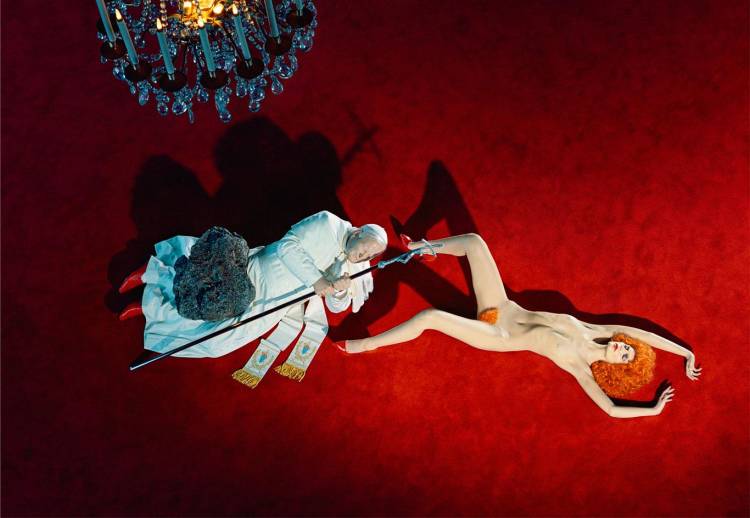Miles Aldridge |‘Why I am me and not you’
British artist and photographer Miles Aldridge combines sickly-sweet luxury, Maurizio Cattelan encounters, and portraits of Marina Abramovi? and Zaha Hadid in Fotografiska New York retrospective

BY HARRIET LLOYD-SMITH
FOR WALLPAPER
Miles Aldridge has a knack for making the surreal hyperreal. At Fotografiska New York, his first US museum retrospective is less of a show and more of a parallel universe. Coinciding with Frieze New York 2021 and titled ‘Virgin Mary. Supermarkets. Popcorn. Photographs 1999 to 2020’, it suggests a wide range of subjects, and doesn’t disappoint.
Aldridge first found acclaim in the mid-1990s with opulent mise-en-scènes doused in acidic hues and eroticism. Inspired by film noir, art history and pop culture, these arresting images probe the undercurrents of society’s idealised domesticity, beauty and sexuality.
Among the 64, career-spanning works in the Fotografiska retrospective is the 2015 series (After Cattelan), created when artist Maurizio Cattelan invited Aldridge to respond to his sculptures during one night together in a Paris museum.
Elsewhere, in portraits of familar faces, Marina Abramovi? lies over spilt milk; Viola Davis beams widely at an unidentified audience; and Donatella Versace oozes opulence. ‘It brings together images created over the last 20 years highlighting the themes that have driven my work; the false promise of luxury, the impossibility of communication, the mystery of life, and why I am me and not you,’ says the artist, who designed Wallpaper’s 15th anniversary limited-edition cover in 2011 (W*150).
Aldridge’s universes are constructed through hyper-stylised staging and props and costumes, saturated colour schemes and dynamic lighting. Drawing on references from the analogue years of cinema, the artist favours film over digital – indeed, each print in this colourful cosmos is captured exclusively on Kodak Colour Negative.
Psychedelic interiors are decked out with the trappings of the midcentury suburban ideal. Candy-coloured telephones and immaculately groomed pets, retail ‘therapy’, and the perpetual quest for self-improvement and perceived success. Suddenly, it’s all too contemporary for comfort.
But it’s the collision between old, new and futuristic worlds that makes Aldridge’s work so utterly disarming. The poised sacrality of Caravaggio, the faux sanctity of the Virgin Mary and the Pope’s fall from grace of Cattelan’s La Nona Ora coexist with sexualised imagery and references to the 20th-century consumer boom. We can almost hear Richard Hamilton whisper Just what is it that makes today’s homes so different, so appealing? to a room filled with Hitchcock, Lynch, Fellini and Kubrick. Even Zaha Hadid looks like a star in her very own Space Odyssey.
Under these gleaming images of domestic and consumer bliss lurks something more poignant, and personal, including Aldridge’s childhood memories of his mother following a shattering divorce.
Ironic, yes. Easy on the eye, certainly, unless you look too long. We’re seduced, naturally, but Aldridge’s work leaves a sickly-sweet taste in the mouth. Under the glossy, paper-thin veneer is a rotten promise of luxury that can never materialise.
Read the article here.